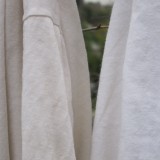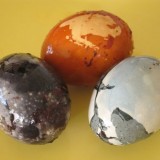So it’s May 15 and I have not met the terms of the Shibori Challenge. I have been playing with both natural dyes and shibori techniques, but have not yet made anything worthy of being sewn up into a cocktail napkin.
I think I’ll have declare my challenge a little over-optimistic. As it when I start any new craft, I’m hitting various walls and spinning around trying to figure out what’s what. But that’s okay. Our motto around here is Go Forth, Embrace Failure, and give Her a Big Kiss.
The foraged, plant-based dyes I’ve been working with are only producing pale tones for me, even with mordants. I’ve made a sort of olive grey out of mint and a light sage out of artichoke and a beige out of coffee. These shades are fine in themselves, especially if you want to dress like a hobbit, but not really strong enough to show off shibori patterns. I know it’s possible to get strong colors out of common plants–it seems other people manage it–but I’m beginning to understand why indigo is the classic choice for shibori techniques.
Wanting to play with shibori and having no luck with local plants, I experimented with turmeric. Turmeric is a “fugitive dye” — a phrase I love — meaning it will fade fast. It fades especially fast in sunlight. Nonetheless, it’s nontoxic and makes a bright, deep yellow with no fuss. And I just happened to have a big container of stale turmeric just wasting away on the shelf. I tried some shibori techniques with that, with some okay first time results — though also with plenty of beginner mistakes.
In the pic above, the white cloth with the yellow lines on it was done by folding the cloth into accordion folds, like a paper fan, then folding that shape into a stack of triangles, then clamping the resulting bundle together and dropping it in the dye bath. Only the edges dye. Supposedly. In mine, the middle edges of the bundle hardly dyed at all, and I’m not sure why. I’ll do a separate post on this with pics soon.
Next I took some old white napkins and twine wrapped parts of them to make the classic spiderweb pattern. That I’ll also cover as its own post.
I’ve decided to do my cocktail napkins with indigo. Interestingly, natural indigo dye is activated through a fermentation process. Love those fermentation processes! Nowadays indigo can be made quickly with chemicals of different sorts, and there’s a very easy to use artificial indigo available, but if you want to make your life hard–and smelly–like me–you will want to make a natural, old-fashioned fermenting vat. Out of stale urine. Yep. There’s also one made out of ammonia and bread yeast which might smell a little better. A very little. But whichever I choose it will take a little while to get the ferment going, and if we choose urine, it will take a while to collect all that urine. So it will be a while before the indigo experiments begin.
If you are curious about the urine vat, check out this nice lady’s account of her own, until I get back to you with more adventures in dyeing.



hey there. have you had heard of mushroom dyes? they tend to make much brighter, longer lasting colors than plants, a really impressive spectrum. i don’t know if you have many mushrooms where you are, that might be the catch. but worth looking into if you know any mushroom fiends, err, friends, who could help you look.
i took a class once with Miriam Rice who wrote the book Mushrooms for Dyes (http://www.mushroomsforcolor.com/Mushrooms_for_Dye-book.htm) she was awesome, and the class was really inspiring. we went out collecting mushrooms then came back and dyed yarn with them. simple as that (almost). the colors were fantastic! of course, i did live in a temperate rainforest at the time. loads of mushrooms everywhere.
How cool! Thanks for the ref. I didn’t know that. But yep, you’re right, mushrooms are very rare here.
I remember using yellow onion skins (lots) with mordant which made a strong yellow… easily found and very strong. When combined with differing amounts of cochineal, it was possible to create a beautiful range of vibrant colors, from saffron to deep reds… forgot what mordant we used though. Also, different fabric fibers take dyes differently.
Brown/red onion skins (I agree, LOTS) work pretty well, even without a mordant. I actually dyed brown eggs in onion skins one year, and they ended up looking like they were made of a beautiful deep dark wood. Also, try strong tea instead of coffee. Leave it in a while.
Experiment with not tying your bundles quite so tightly. Also you could try sewing—-just a running basting stitch—your design and then pulling/tying the thread ends together tightly to scrunch it up. Fun results.
Anon: Yes, I want to try onions, but it does take some time to collect all the peels!
Sue: thanks for the tips! I’ll try looser clamping.
Everyone: Sorry to be slow on my replies. I’ve been camping for the last few days and just got back. Thank you all.
This is another great resource on indigo dyeing:
http://www.aurorasilk.com
I have dyed a lot of fabric using their indigo, its good stuff!
I’ve been following your dyeing with interest, and was wondering why your experimentation avoided one of the easiest to obtain natural dyes. You know those dark papery outside onion skins? Save them up. They dye a nice, deep golden yellow. I saved enough to fill a bucket (literally) then boiled them in about the same bucket full of water. Made a strong orange-yellow dye. No mordant on the wool I dyed with it, and it’s still dark. I imagine it’d work even better with a mordant.
Thanks, Anon. I am saving my peels–but now that it’s warm I’m not using them half so much, so it will take a while.
If you add an iron mordant (handful of rusty nails should do it) you can get a rich dark brown.